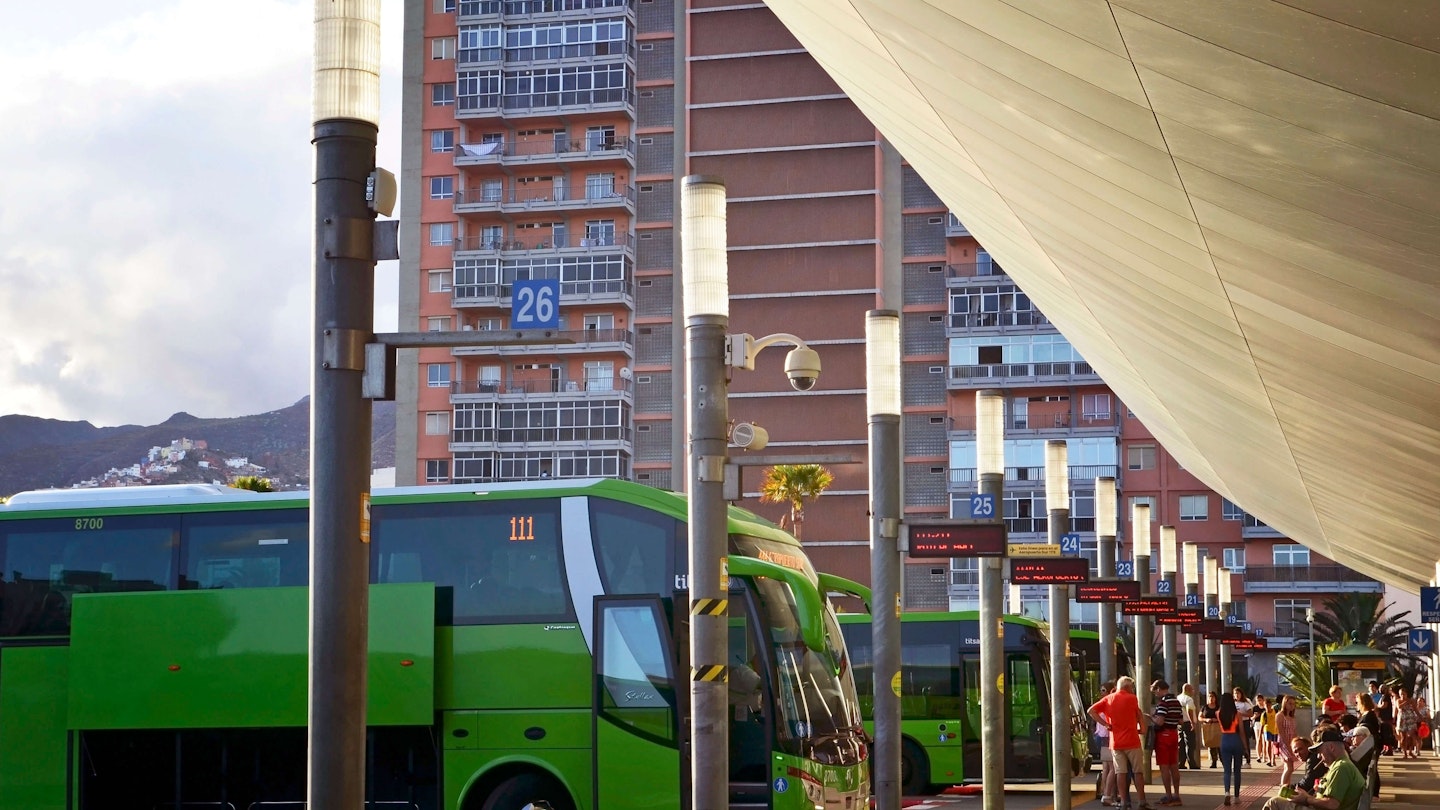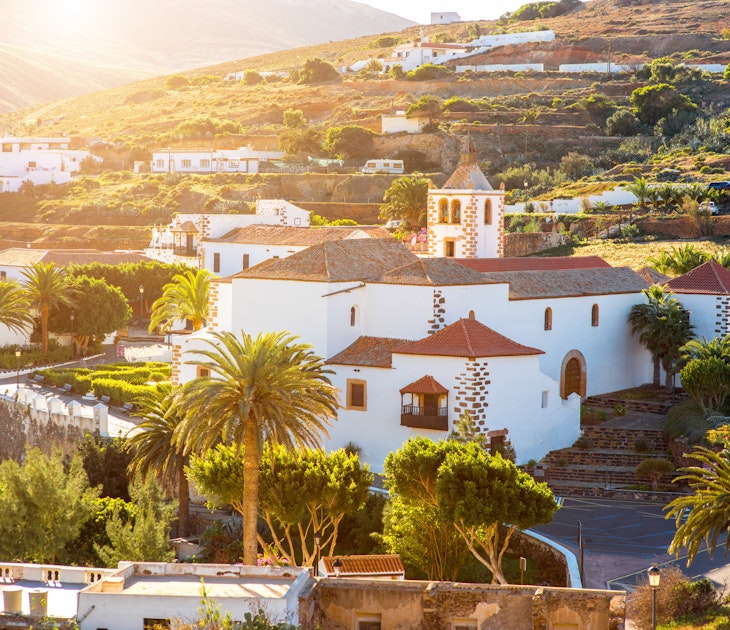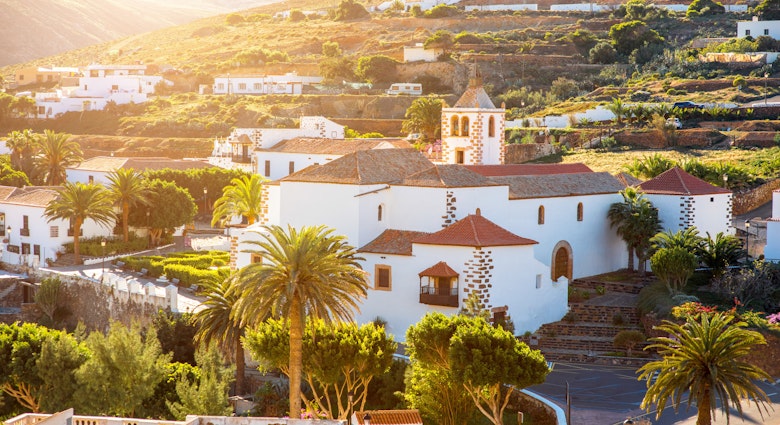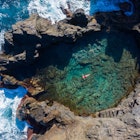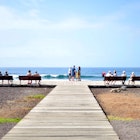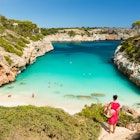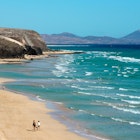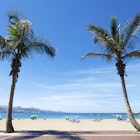Tenerife is an island, but it’s a big one, particularly when you venture off the autopista (highway) and onto the narrow roads that rollercoaster into the remote mountains rippling across the north.
If you’re planning a road trip, you’ll be in your element on Tenerife, breezing through otherworldly landscapes with the volcanic peak of Teide hovering on the horizon, or feeling your stomach flip as you career along cliff-edge roads with the Atlantic raging far below.
Renting a car makes it easier to reach off-the-radar places, but you can get around Tenerife in plenty of other ways. Buses dash between the big towns and resorts for small change, and inexpensive shuttles make airport transfers a breeze. If you want to go greener, rent a bike or an e-bike to see the island in glorious slow motion.
Here are eight of the best ways to get around on your visit to Tenerife.

Rent a car to reach the beach and Tenerife's volcanic heights
With its cinematic volcanic landscapes and coastlines, Tenerife can be a joy to explore by car, but twisty roads and tailgating buses in the mountainous north can put even the most confident drivers on edge.
The island is pretty easy to navigate, especially if you stick to the big roads. The TF-1 highway links the capital of Santa Cruz de Tenerife in the northeast to Costa Adeje in the southwest, while the TF-5 highway connects Santa Cruz to Puerto de la Cruz in the north. But more fun – and gear-crunching, camera-grabbing drama – awaits on the roads that swing around hairpin bends up to Teide National Park (TF-21), Masca (TF-436) and the Anaga Rural Park (TF-12). Avoid peak season if you don’t want to be harassed by impatient bus and coach drivers. The highways also can get jam-packed at rush hour.
Finding a free parking space, particularly near the beach, can be a headache, especially in high season when roads are full of cars trying to cram into too few spaces (make sure you don’t park on any yellow lines). Paid parking generally costs around €1.80 an hour, which adds up over the course of a vacation, so it’s worth seeing if your accommodations offer parking. Never leave valuables in cars, as petty thieves have been known to pounce quickly in towns and resorts.
All the major car rental companies have desks at Tenerife South Airport, with car rental costing a reasonable €15 a day on average. If you want to up your eco game, Cicar rents out electric cars, and Chargemap lists e-vehicle charging points around the island.
Take the quick route to your resort in a taxi or shuttle
Ride-hailing services like Uber have yet to reach Tenerife, but official white taxis with meters are readily available at airports, in resorts and at taxi ranks in bigger towns. If you want to call one, good options include Servitaxi Tenisur in the south and 24-hour Official Taxi island-wide. Make sure you get an estimated cost for your journey before hopping in. A short 15-minute ride – from Tenerife South Airport to Playa de las Americas, for instance – will set you back around €26.
If you're traveling solo or as a couple, it’s cheaper to jump aboard one of the many shuttle buses that ply the island, doing the airport and door-to-door resort rounds. Some also offer affordable private transfers. Reputable companies include Holiday Extras and Hoppa. You can expect to pay as little as €4.50 for a 45-minute transfer from Tenerife South Airport to Costa Adeje.
Hop on a public bus for a budget-friendly spin around the island
No desire to drive? You don’t have to: Tenerife has an efficient bus service that covers a sizable chunk of the island. Titsa runs guaguas – pronounced wa-was – or public buses. You can find timetables, routes and a handy journey planner on the website.
If you intend to travel a lot by bus, invest in a Ten+ daily or weekly travel pass, which cost €10 and €50 respectively. You can buy contactless versions at ticket machines and bus stations or use the ten+Móvil app.
Ride the tram from the old capital to the new
The most exciting way to get from La Laguna to Santa Cruz is by tram. The journey takes 40 minutes, and at €1.35, one-way tickets cost next to nothing. The tram runs from 6am to midnight Monday through Friday, and around the clock on weekends. Tickets can be purchased at machines and service centers, and refilled at newsstands and kiosks.

Get on your bike to breeze along the coast or climb to Mt Teide
Tenerife has taken off as a cycling destination recently, with routes crisscrossing the island and a mild climate making it possible to get on your bike year round. Pro road cyclists often train here in the winter, limbering up on the phenomenal climbs to Mt Teide.
You can easily rent road bikes, mountain bikes and e-bikes in all the main resorts and towns. Expect to pay between €15 and €35 per day, depending on how fancy the wheels are. On the south coast, Free Motion and Bike Point are both good bets; the latter has put together a great selection of GPS routes and offers guided bike tours, both on and off-road. Cycling in Tenerife’s tours swing from a road-bike tour to Masca to a downhill MTB trip at Teide.
Stretch your legs on seafront promenades and mountain trails
Whether it’s to be a sunset stroll along a wave-hammered seafront promenade or a hike into the fantasy laurel forests of the north, Tenerife is a terrific island for walking. Yes, you’ll need wheels to get from A to B, but you can break up the journey by stretching your legs on the paths threading along the coast and into the mountains.
For day or multi-day hikes, Rother and Cicerone publish walking guides that will point you in the right direction. The Tenerife Topo Maps app is also helpful if you plan to stray beyond the beaten track.

Accessible travel in Tenerife
Tenerife has made great progress to become more accessible in recent years. Modern south-coast resort towns have often been designed with mobility needs in mind, including well-equipped hotels with ramps, wheelchair-accessible rooms and traffic-free seafront promenades.
Shuttle companies such as Holiday Extras and cab companies like Official Taxi Tenerife offer wheelchair-accessible transport at no extra cost. Newer public buses are equipped with ramps, and the tram between Santa Cruz de Tenerife and La Laguna is accessible. If you want to rent a wheelchair or mobility scooter during your visit, try Active Mobility Tenerife.
For more travel tips, download Lonely Planet’s Accessible Travel eBook.
Why e-bike is my favorite way to travel in Tenerife
Tenerife is an island with a heck of a lot of altitude, with roads whipping up from the coast to 2000m (6562ft) above sea level, where the stark, rocky, red desert–like landscapes of Teide National Park make you feel like you’ve landed on Mars.
You can blaze up here by car, but to really see the landscape unfold – from ocean to pine forest to rugged, barren mountain – an e-bike is the way to go. It’s possible to road bike up here if you’re super fit, but for everyone else, an e-bike takes the sweat out of the grueling climb to the top, allowing you to focus on those sensational views.

